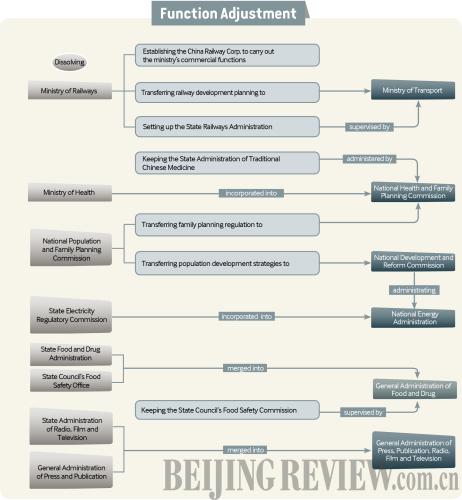|
"For instance, the government will need to build a modern civil servant management system and create a platform where different interest groups can exchange ideas and reach consensus before the government makes decisions," he said.
Another thorny issue is avoiding financial disorder after dissolving the MOR, as its mounting debt has aroused fears of a default.
According to a financial report from the MOR, its debt-to-asset ratio climbed to 61.81 percent at the end of September 2012. Its debts amounted to 2.66 trillion yuan ($427.1 billion) against total assets of 4.3 trillion yuan ($691.9 billion) at that time.
MOR is also China's biggest issuer of corporate notes. It sold bonds worth a total of 164 billion yuan ($26.4 billion) in 2012 to support the development of the country's rail network.
Liu Shiyu, Vice Governor of the People's Bank of China, pledged to keep the credit rating of the bonds issued by the MOR intact after restructuring. Liu made the remark at a press conference on the sidelines of the NPC session on March 13.
"After the restructuring, MOR's commercial loans will be transferred to the proposed China Railway Corp.," he said.
"Chinese banks will continue to extend financial support to railway investment and will work out more comprehensive measures to support railway construction and investment," he said.
Zhang Jianguo, President of the China Construction Bank Corp., said among MOR's liabilities, nearly 2 trillion yuan ($321.8 billion) is from bank loans.
"The government must keep close watch over the debt to guarantee the stability of the financial markets after MOR's restructuring."
Email us at: zhouxiaoyan@bjreview.com
Highlights of the State Council Institutional Reform
According to the restructuring plan, the government will:
Cut, reduce or simplify the review and approval of investment projects. This is in order to minimize the inconveniences and high costs involved when enterprises and individuals are trying to obtain the services they require and boost their independence to start a business or make an investment;
Separate industrial associations and chambers of commerce from administrative departments, and introduce competition through multiple associations in the same industry to boost their independence and vitality;
Integrate identical or similar institutional functions into a sole government department, such as the registries for housing, forest, grassland and land, which currently fall under different government agencies;
Break industrial monopolies and administrative hurdles that hamper the circulation of goods and services, and maintain an open and unified domestic market to ensure fairness and orderly competition;
Increase the government procurement of services and give fair treatment to social organizations in supplying medical, health, education, culture and community services.
(Source: Xinhua News Agency)

| 